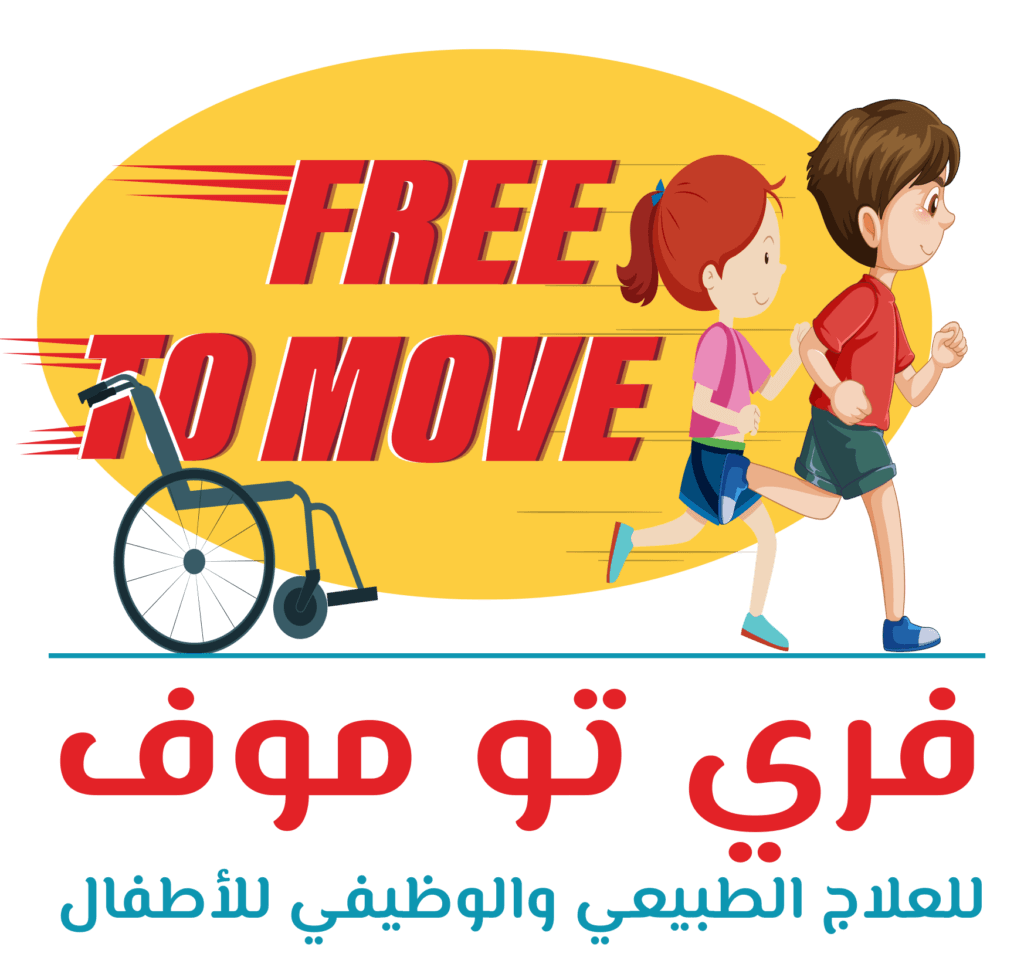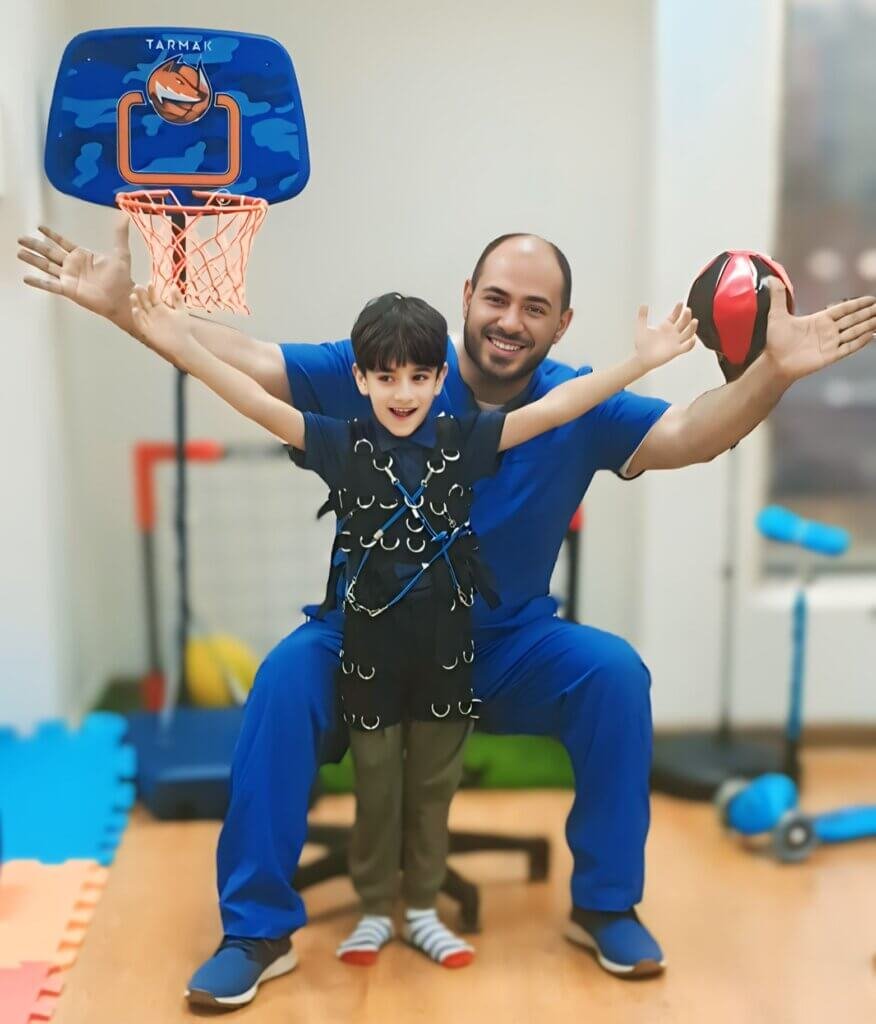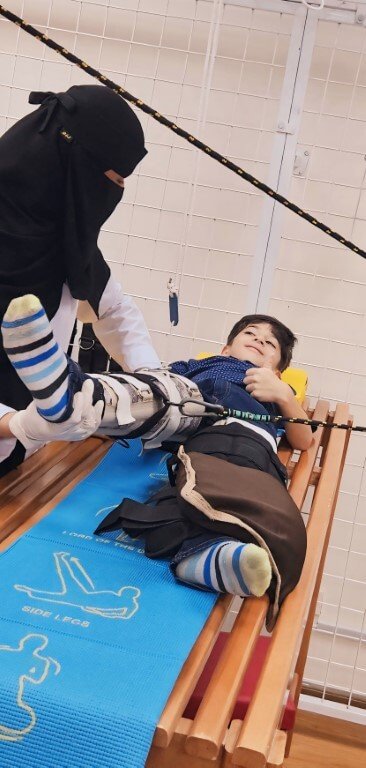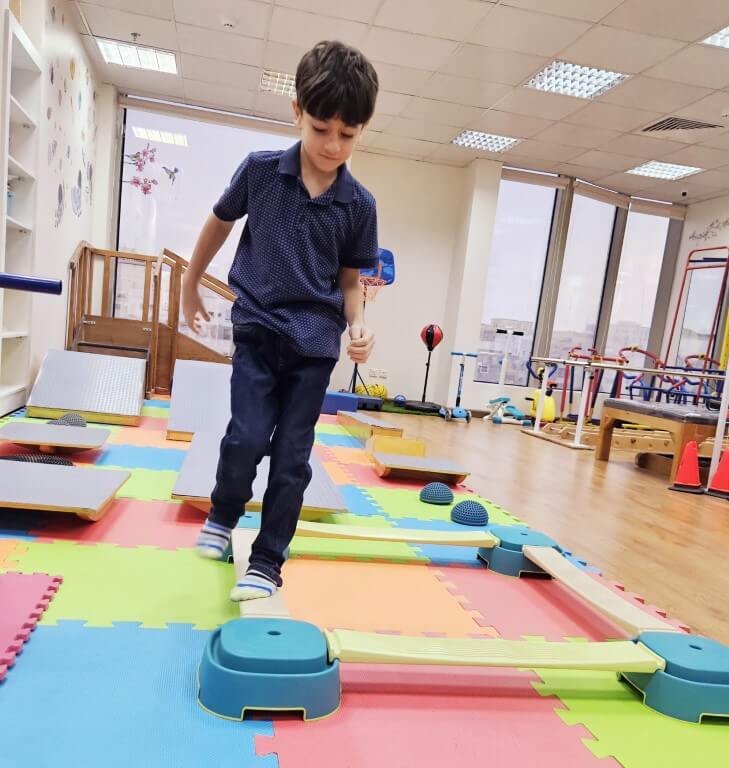Because walking is a vital necessity and every father and mother hopes to see their children take their first step, we have taken care to have at Free to Move Center for Physical and Occupational Therapy many walking teaching tools that help and motivate children to walk for many cases according to their difficulty and severity, including, but not limited to:

1- Lite gait device
The Lite Gait is an advanced medical device used in physical therapy, especially for children with special needs who have difficulties with walking and balance. This device provides the necessary support and assistance for the child while walking, which helps him improve his ability to move and be independent.
How does Lite Gait work?
The Lite Gait consists of a lightweight frame worn around the child's waist, connected by elastic cords that support the body from different sides. The device provides the necessary support and assistance for the child while walking, allowing him to move more freely and reducing the fear of falling.
Benefits of using Lite Gait in physical therapy
- Improve balance: The device helps improve the child's balance and coordination of movements.
- Increased self-confidence: Helps the child feel confident in his ability to walk independently.
- Reduce fear of falling: The device provides the necessary support for the child, reducing his fear of falling and getting injured.
- Facilitating movement: The device helps facilitate movement and reduce the effort required in walking.
- Improve walking pattern: The device helps improve walking pattern and correct any errors in it.
- Developing motor skills: The device helps develop other motor skills such as sitting, standing and moving from one position to another.
- Some devices or games are added to the gait lite device to add an atmosphere of fun and joy while performing exercises.
If you feel that your child is having difficulties crawling or sitting alone, walking, climbing up and down stairs, or making eye-to-eye contact, do not hesitate to contact a physical therapist.

2 - Suspended and parallel parallel
It is an essential tool in the treatment of children with special needs, especially those who have difficulties with movement and balance. It consists of parallel vertical bars suspended from the ceiling, and its height and distance can be adjusted to suit the child's needs.
What are the components of a parallelogram and a suspended parallelogram?
- Bars: Parallel vertical bars made of durable, lightweight material.
- Ropes or chains: used to suspend the rods from the ceiling.
- Adjustment devices: Allows the height and distance of the bars to be adjusted.
- Safety devices: Provide protection for the child during use.
How is the suspended parallelepiped used in therapy?
- Suspension: The child is suspended from the bars using a special safety belt, so that his feet hang slightly off the ground.
- Mobilization: The physical therapist gently moves the child in different directions to help him develop balance and coordination.
- Exercises: Various exercises are performed on the bars to strengthen muscles and improve motor skills.
- Standing and walking training: The bars can be used to help the child stand and walk independently.

3- Dynamic walker for children
The dynamic walker is an essential tool in the treatment of children with special needs, especially those who have difficulties with walking and balance. This tool plays a vital role in physical therapy sessions, as it helps the child develop walking skills and improve his ability to move independently.
What is a dynamic walker?
It is a support frame that provides stability and balance for the child while trying to walk. It differs from traditional walkers in that it allows for more natural movement and encourages the child to use the lower limbs more. The dynamic walker has wheels that help with movement and provide weight support, and its height can be adjusted to suit the child's needs.
Dynamic walker features:
- Adjustability: The walker can be adjusted to suit the child's changing needs, such as changing its height or adding or removing some parts.
- Dynamic Design: The dynamic design of the walker allows for more natural movement compared to traditional walkers.
When is a dynamic walker used in physical therapy sessions?
The dynamic walker is used as part of a comprehensive physical therapy program. The physical therapist will determine when to start using the walker based on the child's condition and progress in treatment.
What are the benefits of using a dynamic walker?
- Improves balance and coordination: Helps the child maintain balance and control his movements.
- Muscle strengthening: Helps strengthen the muscles of the legs and lower body.
- Develops a natural walking pattern: Encourages the child to develop a natural and correct walking pattern.
- Increased self-confidence: Helps the child feel confident in his ability to move and be independent.
- Improve quality of life: Helps the child participate more in daily activities.
- Family integration and interaction: Encourages family involvement in the treatment process and provides support for the child at home.

4 - Hanging walker
A suspension walker is a therapeutic device used in physical therapy for children, especially those with movement and balance difficulties. It consists of a support frame suspended from the ceiling, providing the child with support and encouragement to move and stand.
What are the benefits of using a hanging walker?
- Increased independence: Helps the child achieve more independence in movement.
- Improve quality of life: Helps improve the child's quality of life and enhance his participation in daily activities.
- Family integration: Encourages family involvement in the treatment process and provides support for the child at home.
Finally
The hanging walker is an effective therapeutic tool in helping children with special needs develop walking skills and improve their mobility. However, it must be used correctly and under the supervision of a specialist to achieve the best results. At Free to Move Center, we have distinguished and qualified specialists who will help you make the right decision for your child.
Patience and motivation
Learning to walk takes time and effort, so you must be patient and encourage your child constantly.

5 - UPSEE Suit
The UPSEE suit is an innovative device designed to help young children with delayed walking or mobility difficulties stand and walk independently. The suit consists of a belt worn around the waist by the parent or caregiver, another belt worn around the child's torso, ties that connect the two belts, and special shoes to help the child maintain balance.
suit history
The UPSEE suit was developed by a mechanical engineer named John Sanders, who was looking for a solution to help his son who had a delayed walk. After years of research and development, the UPSEE suit was launched in 2012 and has been very popular with parents and physical therapists.
Suit components
- Main belt: This is a wide belt worn by the parent or caregiver around the waist, and is adjusted to fit the adult's size.
- Baby belt: This is a smaller belt that the child wears around his torso, and is adjusted to fit the child's size.
- Straps: These are straps that connect the main belt to the child’s belt, allowing the child freedom of movement while maintaining his balance.
- Shoes: These are special shoes designed to hold the child's feet in place and help him maintain his balance.
Steps to use UPSEE suit
- Wearing the main belt: The parent or caregiver wears the main belt around his or her waist and adjusts it to fit.
- Wearing the baby harness: The baby wears the baby harness around his torso and adjusts it to fit his size.
- Attaching the belts: The main belt and the child belt are attached using the attached straps.
- Wearing shoes: Special shoes are worn on the child's feet.
- Walking with the child: The parent or companion begins walking with the child, making sure that the child feels safe and supported.
When can the suit be used?
UPSEE suit is useful in the following cases:
- Children with delayed walking: The suit can be used to help these children stand and walk independently.
- Children with polio: The suit can be used to strengthen leg muscles and improve balance.
- Children with brain injuries: The suit can be used to help these children relearn motor skills.
Benefits of the suit
- Improve self-confidence: The suit helps the child feel confident in himself and his abilities.
- Muscle strengthening: The suit helps to strengthen the muscles of the legs, back and abdomen.
- Improves balance: The suit helps improve balance and motor coordination.
- Promote social interaction: The suit helps promote social interaction between the child and his parents or caregivers.
Important note
You should consult your doctor or physical therapist before using the UPSEE suit, to ensure it is suitable for your child and their health condition.

6 - Crawling learning device for children with special needs
What is a crawling machine?
A crawling device is a medical device specifically designed to help children with motor developmental delays or movement difficulties learn to crawl. The device typically consists of a support structure that provides children with the necessary stability and balance as they attempt to move.
The importance of the crawling training device in physical therapy:
- Support and encourage movement: The device provides the necessary support for children with weak muscles or difficulty controlling their movements, encouraging them to move and explore.
- Improves balance and coordination: The device helps develop a sense of balance and coordination between the eye, hand and leg, which contributes to improving the child's general motor skills.
- Muscle strengthening: By using the device, the muscles of the back, abdomen and legs are strengthened, which prepares the child for the next stages of motor development such as standing and walking.
- Boosting self-confidence: Successful use of the device helps increase the child’s confidence in himself and his abilities, which encourages him to continue trying and developing.
When to use a crawling device?
- Delayed motor development: When a child has a delay in developing basic motor skills such as lifting the head, turning, and controlling the neck and back muscles.
- Weak core muscles: If the child has weak abdominal and back muscles, which affects his ability to maintain an upright posture and support his weight.
- Difficulties in motor coordination: When the child has difficulty coordinating the movements of his upper and lower limbs.
- Neurological or skeletal injuries: In cases of injuries that affect the ability to move, such as polio or spinal cord injuries.
Finally
The crawling device is a valuable tool in the treatment of children with special needs, helping them achieve their full motor potential and live more independent and happier lives.

7 - Front walker
It is an important therapeutic tool used in physical therapy sessions to help children who suffer from delayed motor development or walking difficulties. This walker differs from the rear walker in that the support is focused on the front of the body, encouraging the child to push off with his feet and move forward.
When to use a front walker?
The front walker is used in the following cases:
- When the child is able to bear some weight on his feet: The child should be able to stand for short periods and support some of his weight before using a front walker.
- When the goal is to encourage the child to push off with his feet and move forward: The forward walker encourages the child to use his leg muscles effectively to push himself forward.
- When a child needs less support in the back of his body: If a child has relatively good balance in the upper body, a front walker can help him develop his ability to walk independently.
Front walker functions:
- Developing leg propulsion: The front walker helps strengthen the leg muscles, which contributes to improving the child's ability to push with his feet and move forward.
- Improves balance: The walker helps improve the child's balance and coordination of movements.
- Encouraging Independence: The front walker encourages the child to rely on himself in movement and move independently.
- Increased self-confidence: Successful use of a front walker helps increase a child's self-confidence and abilities.
- Speed up the learning process: The front walker helps speed up the learning process of walking and achieve better results in the shortest possible time.
- Increased Active Participation: The front walker encourages the child to actively participate in therapy sessions, increasing the effectiveness of the treatment.
- Improve Quality of Life: The front walker helps improve the child's quality of life by increasing his independence and ability to interact with his surroundings.
Finally
The front walker is a valuable therapeutic tool that helps children with special needs reach their full motor potential and live more independent and happier lives.

8 - Rear walker
A rear walker is a therapeutic device specifically designed to help children with motor delays or walking difficulties develop their motor skills and improve their ability to stand and walk independently. This walker differs from a front walker in that the support is focused on the back of the body, encouraging the child to take steps forward rather than relying on pushing with the feet.
When to use a back walker?
The back walker is used in the following cases:
- When your child needs more support in the back of their body: If your child has weak back muscles or unstable knees, a rear-facing walker provides the necessary support.
- When the child has weak leg muscles: The back walker helps strengthen the leg muscles and improve the child's ability to bear his weight.
- When baby needs encouragement to take steps forward: A rear walker encourages baby to move his feet forward instead of relying on foot push-off.
- When the goal is to improve posture and strengthen the back and leg muscles: The back walker helps improve correct posture and strengthen the back and leg muscles.
In cases of excessive tension in the upper limb: When the child is unable to straighten the elbow joint, which causes the child to lean forward and lose balance with a misalignment of the trunk, it is preferable to use a rear walker as it will help the child to push down and be able to move by straightening the elbow.
- In case of arching of the back with the shoulder joint bending and tilting forward.
Finally
The back walker is a valuable therapeutic tool that helps children with special needs reach their full motor potential and live more independent and happier lives.

9 - Electric walker in training children with special needs by integrating technology into physical therapy
The electric walker is an innovative therapeutic tool used in physical therapy sessions to help children with special needs improve their motor skills and develop their ability to walk. These devices rely on modern technologies to provide an interactive and stimulating therapeutic environment, which increases the effectiveness of treatment.
The importance of using an electric walker in physical therapy for children:
The electric walker is an advanced therapeutic tool that plays a crucial role in improving the movement and walking abilities of children with special needs. These devices are an integral part of modern physical therapy programs for several reasons:
- Improve balance and coordination: The electric walker helps improve the sense of balance and coordination between the upper and lower limbs, which contributes to the development of fine and gross motor skills.
- Muscle strengthening: The walker strengthens the muscles of the legs, back and abdomen, which enhances the child's strength and ability to bear weight and move independently.
- Boosting Self-Confidence: Successful use of the walker helps increase the child’s confidence in himself and his abilities, which prompts him to participate more actively in therapy sessions.
- Stimulates natural movement: The walker encourages the child to take natural steps and improves the walking pattern, bringing him closer to the natural movement of healthy children.
- Provides a fun therapeutic environment: The electric walker provides a fun and stimulating therapeutic environment for the child, which increases his commitment to treatment and makes it more enjoyable.
- Personalized Therapy Program: Therapy programs on the walker can be customized to meet each child's individual needs, ensuring maximum benefit.
- Increased active participation: Games and on-screen interactions encourage the child to actively participate in therapy sessions, increasing the effectiveness of therapy.
Integrating Technology with Treadmill Therapy:
At Free to Move Physical and Occupational Therapy, we offer different ways to integrate technology into our children’s rehabilitation programs, such as:
- Nintendo: Specialized video games on the Nintendo console display moving images and objects on a screen in front of the child. The child interacts with these images and objects through his movements on the walker, which encourages him to move more actively and focused.
- Mirror: Place a mirror in front of the child so that he can see himself moving. This helps improve body awareness, coordination and performing movements in the correct manner and style.
short
The walker is a valuable therapeutic tool that greatly contributes to improving the movement and walking abilities of children with special needs. By providing a stimulating therapeutic environment and customizing the therapeutic programs, the walker can help children make significant progress in developing their motor skills and improving their quality of life.

10 - Cage Suspended Device and Its Uses in Pediatric Physical Therapy
What is a hanging cage device?
A suspended cage is a therapeutic device used in physical therapy for children, especially those who have difficulties with movement and balance. This device consists of an open-top cage or container, suspended from the ceiling by ropes or chains. The child is placed inside this cage, allowing him to move freely in all directions while feeling safe and supported.
What are the main benefits of using a hanging cage device?
- Improves mobility: Helps increase range of motion and reduce muscle stiffness.
- Pain Reduction: Helps relieve pain and improve flexibility.
- Increased body awareness: Helps the child better understand how to move his body.
- Improve mood and self-confidence: Helps improve mood and reduce frustration.
Cases that benefit from different types of walkers in physical therapy for children:
- Cerebral Palsy: Helps improve balance, coordination and muscle strength.
- Polio: Supports the child in standing and walking and helps him develop a normal gait pattern.
- Down Syndrome: Helps improve muscle strength, balance and develop motor skills.
- Post-operative and lower extremity fractures: Helps support weight and encourage movement after surgery or a period of rest.
- Sprains: Helps rehabilitate the joint and strengthen the surrounding muscles.
- Muscular dystrophy: Supports the child in standing and walking and maintains the strength of the remaining muscles.
- Premature babies: Helps develop basic motor skills and strengthen muscles.
- Children with delayed motor development due to other causes: Helps improve balance, coordination and develop a normal gait pattern.
- Children with brain or spinal cord injuries: Walkers help rehabilitate children who have suffered injuries that affect their ability to move.
- Children with weak leg muscles: Helps strengthen muscles and improve weight-bearing ability.
- Children with balance problems: Helps improve sense of balance and coordination.
Important notes when using different types of walkers:
- Always Safety First: Make sure the dynamic walker is safe and suitable for the child's size and weight.
- Collaborate with a specialist: You should work closely with your physical therapist to ensure proper use of the walker and achieve the best results.
- Patience and motivation: Learning to walk takes time and effort, so you must be patient and encourage your child constantly.










